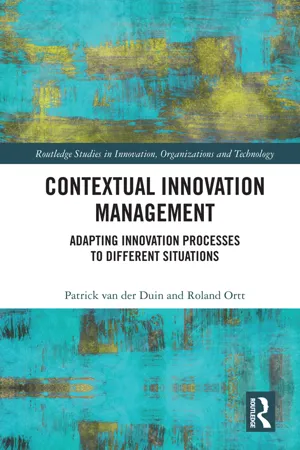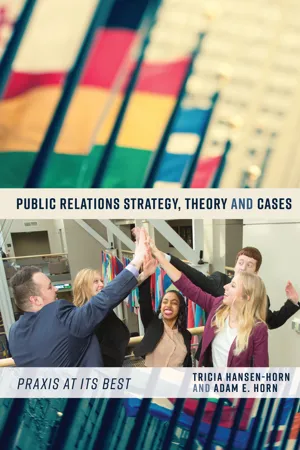Business
Contingency Theory
Contingency theory in business suggests that there is no one-size-fits-all approach to management. Instead, it emphasizes that the most effective way to manage an organization depends on various situational factors, such as the environment, technology, and culture. This theory advocates for adapting management practices to fit the specific circumstances of a given situation.
Written by Perlego with AI-assistance
Related key terms
1 of 5
9 Key excerpts on "Contingency Theory"
- eBook - ePub
Contextual Innovation Management
Adapting Innovation Processes to Different Situations
- Patrick van der Duin, Roland Ortt(Authors)
- 2020(Publication Date)
- Routledge(Publisher)
3 From Contingency to Contextual The faith in success factors is persistent and widespread. In contrast, contingency-theory is a field in management science that adopts the premise that companies should adapt their organization and strategy to the environment or the context. Contingency Theory refutes the idea of a generic and fixed set of success factors. The fact that the environment changes means that companies have to change too. In the natural sciences, changes can be explained using a fixed and generally valid set of equations. In the social sciences, to which management science belongs, change means that different variables and different relationships between them become important, and hence the set of equations to explain the phenomena of change are themselves changing. The contingency perspective is a very relevant perspective to explore and develop specific innovation management approaches that fit particular companies and their environment. 3.1 Introduction: Contingency Theory The notion that business success in general and innovation success in particular can be explained by a general and fixed set of success factors is widely held. In this book, we argue that it is better to consider the way that organizations innovate as context dependent. This notion is theoretically and scientifically rooted in a management theory known as ‘Contingency Theory’. As is the case with many scientific theories, it is not always clear who developed the first ideas and hence can be called the grandfather or grandmother. A classical reference is the work of Paul R. Lawrence and Jay W. Lorsch who with their 1967 book ‘Organization and environment’ hoped to “renew interest in Contingency Theory” (Lawrence and Lorsch, 1967, p. xii). They refer to scientists such as T. Burns and G.M. Stalker (see section 3.5) and others (including the famous management scientist Alfred Chandler) who have laid down the foundation of Contingency Theory - Patti Chance(Author)
- 2013(Publication Date)
- Routledge(Publisher)
Contingency Theory applied to leadership explores the relationship of a leader’s style to the effectiveness of the organization. Although not definitive, this approach to Contingency Theory is useful to consider the connections among staff attitudes and personalities, a leader’s relationship with staff, and the nature of the tasks in which staff are engaged. It points out that there is not one ideal style of leadership, and that the effectiveness of a leader’s style will depend on the situation.Applications for School Leaders
Understanding Contingency Theory will help school leaders♦ Identify outside variables that impact a school ♦ Match leadership style with the needs of the school ♦ Consider the relationships among teachers’ personalities and attitudes, work-related tasks, and leadership style ♦ Understand the importance of short- and long-term contingency planning ♦ Appraise the impact of a school’s organizational structure on responses to external pressures and demandsThe Uncertainty Factor: Contingency Theory Applied to Organizations
Contingency Theory, when approached from an organizational perspective, is related to the concept of open systems and the notion of loose coupling.Open system theory explains the relationships and exchanges between the organization and the external environment. Loose coupling refers to the connections among various units within the organization and describes units as interdependent, but at the same time each has its own identity, functions, and separateness. Contingency Theory examines the internal adjustments of the organization as it responds to events in both the external and internal environments (Hanson, 1979).Open Systems
Open system theory emanates from the analogy of organizations as organisms. Thompson (1967/1996), in writing about open systems, referred to organizations in Darwinian terms:The complex organization is a set of interdependent parts which together make up a whole, which in turn is interdependent with some larger environment. Survival of the system is taken to be the goal, and the parts and their relationships presumably are determined through evolutionary processes. Dysfunctions are conceivable, but it is assumed that an offending part will adjust to produce a net positive contribution or be disengaged, or else the system will degenerate (p. 289).- eBook - ePub
- Peter Spillard(Author)
- 2014(Publication Date)
- Taylor & Francis(Publisher)
Chapter Three THE CONTINGENCIES Introduction: The Nature of Contingency TheoryThis chapter will examine the contingencies that affect the ultimate choice of organizational structure from among the possibilities discussed in Chapter Two ; recognizing, of course, that as the balance of these contingencies change, then so ought the organizational solution.Galbraith1 , in introducing the Contingency Theory of organization, says:-“This theory is based on two conclusions drawn primarily from large-scale empirical studies. (a) There is no best way to organize. (b) Any way of organizing is not equally effective.Thus, we can observe a wide range of effective organizations but their differences are not random. The form of organization makes a difference. All of which suggests a new set of questions. On what factors does the choice of organization form depend? What are the characteristics of organizational contexts which appear to make a difference?”Khandwalla2 continues:-“The basic idea of the contingency theorists is that the nature of the organization’s technology, its size, its legal incorporation, the character of its markets and other factors confront the organization with some opportunities as well as constraints and problems and therefore set the tone of the organization’s adaptation as revealed by its structure. The idea is an elaboration of the biologist’s functionalist view of the adaptation of living forms to their environment.”The work of Woodward, Burns and Stalker, Lawrence and Lorsch, Thompson, Chandler and Mintzberg has all helped to initiate discussion of the significance and nature of the contingencies that shape the ideal organization.It seems sensible to proceed by constructing a model which attempts to plot the extent of the contingencies existing in addition to those factors already identified in Chapter 1 . These comprise the independent variables which affect the dependent variable labelled “organizational structure”. It is important always to bear in mind that there is no such thing as the perfect solution or even an ultimate goal for which to strive in organizational design. All the time contingency theorists are talking about a best fit with the environment rather than an ideal model that covers all circumstances. It is this premise that really underpins Contingency Theory – and which at the same time deprives it of neatness and precision. Contingency Theory, by its very nature, is a messy, untidy theory – if, indeed, it is a - eBook - PDF
- A.J. Berry, J. Broadbent, D.T. Otley, A.J. Berry, J. Broadbent, D.T. Otley(Authors)
- 2019(Publication Date)
- Routledge(Publisher)
In addition work by corporate strategists such as Chandler As has been shown in the preceding section, a (1962) was emphasising the relationship between substantial body of opinion holds that there is no the strategy an organisation selected in order to universally “best” design for a management achieve its goals and the organisational structure accounting information system, but that “it all that was most appropriate for it to adopt. By early depends” upon situational factors. However assent 1970 Contingency Theory was firmly established as to such a general proposition does not produce the dominant approach in organisation theory consensus on what specific contingencies should (Child, 1977) although it has subsequently become result in particular configurations on accounting subject to increasing criticism (Wood, 1979). information. Indeed, a great variety of suggestions 3 It is appreciated that in some circumstances other features will be of greater importance than budget accuracy, and that accuracy may well be sacrificed in order to gain other benefits. 3Although this latter development can be traced back to Caplan (1966) he did not include the contingency framework in his outline of modern organisational theory. _______________________________ Management Control Theory ___________________________ 309 Contingency Theory OF MANAGEMENT ACCOUNTING: ACHIEVEMENT A PROGNOSIS 417 are available, some stemming from empirical work pooled, sequential and reciprocal interdependence; and others from theoretical speculation based on environmental relationships in terms of his the results of work in organisation theory. In this stable-dynamic and homogeneous-heterogeneous section the content of the main contingent dimensions; and internal factors include the nature formulations that have been proposed is reviewed, of the tasks performed, types of people, interpersonal relationships and the ability to Em pirical studies measure and quantify functions. - eBook - PDF
Organizations
Management Without Control
- Howard P. Greenwald(Author)
- 2007(Publication Date)
- SAGE Publications, Inc(Publisher)
Different principles for assigning responsibilities and channeling effort will work best in organizations engaged in similar tasks, challenged by similar forces, and pursuing similar goals. According to Contingency Theory, uncertainty and information play a key role in determining how an organization should be configured. 9,10 Some organizations enjoy high levels of certainty, knowing that their requirements will remain constant over time. In such organizations, members need very little information to do their work: a fixed set of instructions is adequate. In organizations whose tasks are changing, members need a great deal of information. No simple set of instructions will work. Members need to be given the liberty to make personal judgments among alternatives, often in a rapid-response manner. The contingency model helps explain variations within as well as between organizations. Human relationships, management practices, and culture can differ from department to department. Even in a small firm, for example, the accounting department is likely to be more formal than the marketing department, the employee fitness room, or the child care center. The Contingency Theory can be seen as complementing rather than contradicting the rational systems theory. At least one author has referred to a “rational-contingency” theory. 11 Under this formulation, organizations pursue definite goals, but do so in a manner that is sensitive to specific characteristics of their environments. Organizational Theories and Perspectives —— 51 Thus, electric utilities located in urban Massachusetts and rural Utah would be likely to operate differently in some respects. The Massachusetts company would probably expend more of its resources on pollution abatement and public relations. The central principle of Contingency Theory is that constraints on the “free will” of the organization determine the configuration of social relations and allocation of resources within it. - eBook - PDF
Public Relations Strategy, Theory, and Cases
Praxis at Its Best
- Tricia Hansen-Horn, Adam E. Horn(Authors)
- 2018(Publication Date)
In fact, what you can and should do depends … on many real and perceived factors that contribute to perceived conflict and threats. But, not all people agree with this assessment. They argue, instead, that Contingency Theory is just an extension or enhancement of the two-way symmetrical model. However, given the excellence model ideal of co-creation of meaning in the best interests of all parties involved, it seems that Contingency Theory introduces a degree of difference as “when possible” in the best interests of all. Conclusion Contingency Theory sensitizes us to conflict, competition, and threat as part of organizational functioning and as important to understanding organizational goals and sustainability. Its proponents represent public relations complexity through the dimensionality of threats appraisal model and the contingency con- tinuum ranging from pure accommodation to pure advocacy. Contingency Theory also advances 13 stances an organization may assume in response to WIGO and as a result of professional understandings and assessments of more than 80 “it depends” factors. Chapter Exercises Case Application Lens: Contingency Theory Public relations definition: The strategic management of conflict and competition in the best interests of an organization and, when possible, also in the interests of key publics. Contingency theorist intent: To understand how public relations leads the way in the recognition of threats, and adopting stances to conflict and competition, in an VALUE IN APPLIED THEORY | 69 “it depends” advocacy to accommodation manner that helps accomplish organi- zational goals. Contingency Theory questions 1. Is there competition? If so, describe it as you perceive it. 2. Is there conflict? If so, describe it as you perceive it a. How relevant is the conflict to the organization’s stated objectives? How relevant should it be? 3. - eBook - PDF
- Ahmed Riahi-Belkaoui(Author)
- 2001(Publication Date)
- Praeger(Publisher)
6 Contingency Approaches to the Design of Accounting Systems INTRODUCTION A perfect match between specific contingencies and the various characteristics of accounting systems is the objective of the method of theoretical and empirical research generally known as the contingency approach to the design of account- ing systems. Research of this type dismisses the notion that universality in the design of accounting systems can be reached to accommodate all situations through a search for the factors that can best ensure the effectiveness of the accounting systems. The purposes of this chapter are to explain the contingency approach and to elaborate on the various theoretical and empirical studies that have adopted it. Contingency Theory The Contingency Theory approach to the design of accounting systems assumes that a general strategy applicable to all organizations does not exist. On the contrary, it assumes that the design of various components of accounting systems depends on specific contingencies that can create a perfect match. It is then the perfect link or match between the design of accounting systems and the specific contingencies that is the scope of Contingency Theory. To date, the contingency formulations have considered the effects of technology, organizational structure and theory, and the environment in attempting to explain how accounting sys- tems differ in various situations. All of these formulations point to the accepted thesis that there is no universal, “best design” for a management accounting information system, and that “it all depends upon situational factors.” 1 - eBook - PDF
- Alan Bryman, David Collinson, Keith Grint, Brad Jackson, Mary Uhl-Bien, Alan Bryman, David Collinson, Keith Grint, Brad Jackson, Mary Uhl-Bien(Authors)
- 2011(Publication Date)
- SAGE Publications Ltd(Publisher)
The third section describes three types of situational influence that should be differentiated. In the fourth section each of the early contingency theories is briefly described. Then conceptual limitations common to most of the theories are identified, the research findings are summarized, and limitations of the research are identified. The chapter ends with a general evaluation of the contingency approach and suggestions for developing stronger theories and designing better research. GENERAL DESCRIPTION OF CONTINGENCY THEORIES Contingency theories describe how aspects of the leadership situation alter a leader’s influence on an individual subordinate or a work group. The independent variables in most contingency theo-ries are leadership behaviors. The dependent vari-able is usually a measure of leadership effectiveness (e.g., subordinate satisfaction or performance, or team performance). The situational variables are conditions the leader cannot change in the short term, including characteristics of the work (e.g., task structure, role interdependence), characteris-tics of subordinates (e.g., needs, values), charac-teristics of the leader (expertise, interpersonal stress), and characteristics of the leadership posi-tion (leader authority, formal policies). Some contingency theories also include mediating vari-ables to explain the influence of leader behavior and situational variables on performance outcomes. The mediators are usually subordinate character-istics that determine individual performance CONTINGENCY THEORIES OF EFFECTIVE LEADERSHIP 287 (e.g., role clarity, task skills, self-efficacy, task goals), but mediators can also include group-level characteristics that determine team performance (e.g., collective efficacy, cooperation, coordination of activities, resources). A leadership theory can have both universal and contingency aspects, and the distinction between the two types of theories can be over-stated. - eBook - PDF
Leadership
Research Findings, Practice, and Skills
- Andrew DuBrin(Author)
- 2022(Publication Date)
- Cengage Learning EMEA(Publisher)
A realistic perspective on the reliance on evidence in making a decision is that evidence can encompass much more than the type of evidence found in profes- sional journals. The Center for Evidence-Based Man- agement says that four sources of evidence should be considered when making a decision. ● Findings from empirical studies published in aca- demic journals such as the Journal of Applied Psy- chology, The Leadership Quarterly, and the Academy of Management Journal. ● Data, facts, and figures gathered within the orga- nization such as objective performance data and turnover statistics. ● The experience and judgment of practitioners, such as a veteran leader. ● The values and concerns of the stakeholders who may be affected by the decision, such as workers Reader’s Roadmap So far in this book, we have examined the nature of leadership, the inner qualities of leaders, and leadership styles, including contingency leadership. In the next chapter, we focus on a topic that incorporates many of these ideas: lead- ership ethics and social responsibility. Summary Theories of contingency and situational leadership build on the study of leadership style by adding more specific guidelines about which style to use under which circumstances. Leaders are most effec- tive when they make their behavior contingent on situational forces, including group member charac- teristics. Organizational effectiveness is affected by situational factors not under the leader’s control. Situ- ations shape how leaders behave, and they also influ- ence the consequences of leader behavior. continued on following page Copyright 2023 Cengage Learning. All Rights Reserved. May not be copied, scanned, or duplicated, in whole or in part. Due to electronic rights, some third party content may be suppressed from the eBook and/or eChapter(s). Editorial review has deemed that any suppressed content does not materially affect the overall learning experience.
Index pages curate the most relevant extracts from our library of academic textbooks. They’ve been created using an in-house natural language model (NLM), each adding context and meaning to key research topics.








